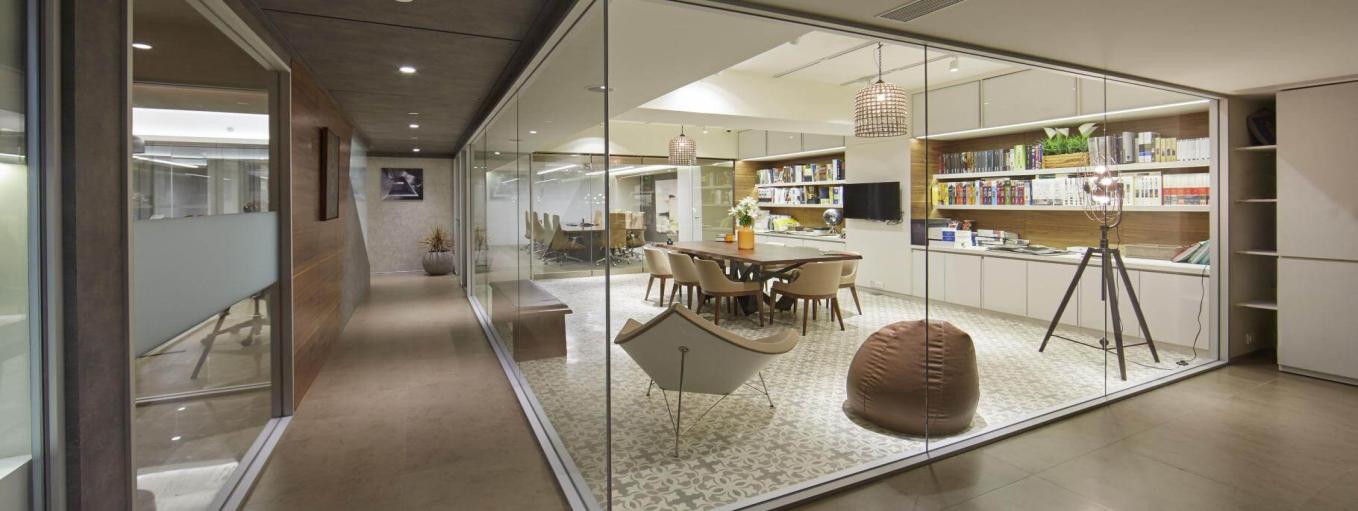


Glass is veering away from being just a building material to becoming an indispensable part of aesthetic interiors and attractive exteriors. It brings an inherent sophistication that can up the glamour quotient of any space. And it is not just about the visual appeal that it exudes, but more significantly, the several functional benefits that glass extends.
Glass is processed in various different ways that give it a distinct look and texture. Let us explore and discover what lends glass its life, lustre, longevity and the ability to liven up living and working spaces.
What is sandblasting?
Sandblasting is essentially the process of blasting the surface of glass with grit which peppers the surface, giving it a milky white appearance. It describes the act of propelling very fine bits of material at high-velocity, by steam or air, to clean or etch a surface.
How is sandblasting done on glass?
Sandblasting gives the glass a translucent surface, which is usually rougher than that obtained by etching. During sandblasting, only the areas that are to remain transparent are masked for protection. The depth and degree of the translucency of the sandblasted finishing vary with the force and type of sand used. The sandblasting technique is used to obscure visibility through glass, but the glass continues to transmit light as it is diffused through the surface.
Dividers, doors and shower enclosures are some of the most popular architectural uses of sandblasted glass. Other interior design applications include: shower screens, partitions and interior screens, furniture, etc.
Architectural uses of Sandblasted Glass
Sandblasting effects on shower doors can create wonderfully frosted looks to complement the appearance of any bathroom. Sandblasted glass panels on front doors are popular and can add elegance to the front door of a home.
Even small amounts of sandblasted glass can add interest to any residential or commercial outdoor or indoor space. Some upscale hotels or museum lobbies feature large panels of glass with detailed sandblasted etchings that may include figures or animals. Smaller artistic sandblasted glass panels may be used as architectural accents in homes such as in front halls and kitchen backsplashes.
What are the benefits of sandblasting on glass?
Although glass etching is extremely decorative, sandblasting is not done for aesthetics alone. It can be an attractive and practical solution to reduce the appearance of fingerprints on glass. The frosted appearance and/or different texture sandblasting on glass can make fingerprints and smudges more difficult to see than if the glass was left as is. Sandblasting glass can also help it repel dirt build-up on shopping mall doors and shower enclosures.
What is acid etching?
Acid etching is a process that uses a strong acid to cut into another substance. Acid-etched glass has a distinctive, uniformly smooth, satin-like appearance and admits light.
How is acid etching done on glass?
Acid-etched glass is produced by acid etching one side of float glass. It is created by cutting a design stencil made of an abrasive resistant material like vinyl or rubber. The resulting stencil (resist) is then secured onto the glass to be etched. A blaster gun, powered by an air compressor, is used to bombard the glass with the abrasive. Every part of the glass that is not covered by the resist will take the frosted effect while the parts protected by the resist will remain clear, thus producing a piece of etched glass.
Acid-etched glass is perfect for both interior and exterior applications in homes, restaurants, hotels, commercial buildings, etc. They are suitable especially for: Interior partitions, railings, shelves, shower and bath enclosures, doors and windows, glass walls, kitchens and interior and exterior doors.
Lacquered Glass is produced by depositing and then baking a highly durable and resistant lacquer to one side of the glass. It is a highly durable material, requiring low maintenance, since the lacquer coating is protected by the glass. Lacquered Glass is used in domestic and commercial locations such as offices, hotels, museums, theatres and cinemas.
Tiffany glass is the generic name used to describe the many and varied types of glass developed and produced by Louis Comfort Tiffany, (1848-1933), one of the most famous stained glass artists of the United States.
Most people think of Tiffany glass as decorative bronze lamps with intricate multicolored, stained-glass shades, but it actually includes other glass products, including solid color windows, painted art glass shades and lamps, and flat and pressed glass.
Behind what looks like a fragile material, there is a lot that goes into processing glass. Each type of glass has its distinct identity, thanks to the meticulous processing that it undergoes.
Indeed, the end-user is spoilt for choice when it comes to choosing from the most extensive range of glass types. Based on individual sensibilities, climate, applications and other requirements, a prudent and informed choice can be made from the various types of processed glass available.
What is the significance of processing glass?
Glass processing enhances the material's functionality, durability, and aesthetics. It transforms glass from a basic building material into a versatile design element suitable for diverse applications in interiors and exteriors.
What is sandblasting on glass, and what are its benefits?
Sandblasting involves blasting the glass surface with fine material to create a frosted, translucent texture. Its benefits include enhanced privacy while allowing light transmission, reduced visibility of fingerprints and smudges, addition of decorative and practical value to glass applications.
Where can sandblasted glass be used?
Common applications include Shower screens, partitions, interior screens, furniture, doors etc.
How is acid etching on glass different from sandblasting?
Acid etching uses strong acids to create a smooth, satin-like appearance, whereas sandblasting employs abrasive materials to roughen the surface. Acid-etched glass has a uniformly smooth finish, while sandblasted glass has a coarser, frosted texture.
What are the applications of acid-etched glass?
Acid-etched glass is ideal for Interior partitions and walls, eailings and shelves, shower enclosures, doors, and windows besides other decorative installations.
What is lacquered glass, and how is it made?
Lacquered glass is created by depositing and then baking a highly durable and resistant lacquer to one side of the glass. It is used in a variety of interior design applications because of its glossy, vibrant and low-maintenance finish.
What factors should one consider when choosing processed glass?
Key considerations while choosing processed glass include: